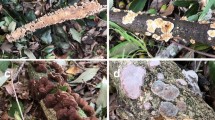Abstract
Five different species of known ecto-mycorrhizal fungi: Cenococcum geophilum, Amanita muscaria, Tricholoma aurantium, Rhizopogon luteolus and Rhizopogon roseolus were studied for their ability to metabolize the major components of plant cell walls. All strains were able to decompose 14C-labelled plant lignin, 14C-lignocellulose and 14C-DHP-lignin at a rate which was lower than the one observed for the known white rot fungi Heterobasidion annosum and Sporotrichum pulverulentum. Also 14C-(U)-holocellulose was relatively less degradable for the mycorrhizal fungi than for the white rotters. On the other hand, aromatic monomers like 14C-vanillic acid were decomposed to a much higher extent by two species of mycorrhizal fungi compared to the activity observed for Heterobasidion annosum. The results of the experiments reveal that these stains of mycorrhizal fungi are well able to utilize the major components of plant material and thus can contribute to litter decomposition in the forest floor.
Similar content being viewed by others
References
Ander P, Eriksson KE (1976) The importance of phenol oxidase activity in lignin degradation by the white rot fungus Sporotrichum pulverulentum. Arch Microbiol 109:1–8
Björkman E (1942) Über die Bedingungen der Mykorrhizabildung bei Kiefer und Fichte. Symb Bot Upsal 6:1–191
Björkman E (1944) The effect of strangulation on the formation of mycorrhiza in pine. Svensk Bot Tidskr 43:223–262
Björkman E (1970) Mycorrhiza and tree nutrition in poor forest soils. Stud Forest Suec 83:1–24
Curtis H (1975) Biology. Worth Publ, New York
Falck R, Falck M (1954) Die Bedeutung der Fadenpilze als Symbionten der Pflanzen für die Waldkultur. JD Sauerländers Verl, Frankfurt/M
Frank B (1885) Über die auf Wurzelsymbiose beruhende Ernährung gewisser Bäume durch unterirdische Pilze. Ber Dt Bot Ges 3:128–145
Haars A, Hüttermann A (1980) Macromolecular mechanism of lignin degradation by Fomes annosus. Naturwissenschaften 67:38–40
Haider K, Lim SU (1965) Darstellung von Coniferyl- und Synapinalkohol markiert in den Methoxylgruppen durch 14C. J Labell Comp 1:294–299
Haider K, Trojanowski J (1975) Decomposition of specifically 14C-labelled phenols and dehydropolymers of coniferyl alcohol as models for lignin degradation by soft and rot fungi. Arch Microbiol 105:33–41
Haider K, Trojanowski J (1980) A comparison of the degradation of 14C-labelled DHP and corn stalk lignins by micro- and macrofungi and bacteria. In: Kirk TK, Higuchi T, Chang HM (eds) Lignin biodegradation. CRC-Press. Boca Raton, Florida, pp 111–134
Hering TF (1982) Decomposing activity of basidiomycetes. In: Frankland JC, Hedger JN, Swift MJ (eds) Decomposer basidiomycetes, their biology and ecology. Univ Press, Cambridge, pp 213–225
Kropp BR (1982) Fungi from decayed wood as ectomycorrhizal symbionts of western hemlock. Can J For Res 12:36–39
Lewis DH, Harley JL (1965a) Carbohydrate physiology of mycorrhizal roots of beech. I. Identity of endogenous sugars and utilization of exogenous sugars. New Phytol 64:224–237
Lewis DH, Harley JL (1965b) Carbohydrate physiology of mycorrhizal roots of beech. II. Utilization of exogenous sugars by uninfected and mycorrhizal roots. New Phytol 64:238–255
Lewis DH, Harley JL (1965c) Carbohydrate physiology of mycorrhizal roots of beech. III. Movement of sugars between host and fungus. New Phytol 64:256–269
Lyr H (1963) Zur Frage des Streuabbaus durch ektotrophe Mycorrhizapilze. Mykorrhiza, Intern Mykorrhiza Symp, 25.–30. April 1960, Weimar. Fischer, Jena, pp 123–142
MacDougal DT, Dufrency J (1944) Study of symbiosis of Monterey pine with fungi. Yearb Amer Phil Soc 1944:170–174
Melin E, Nilsson N (1957) Transport of 14C-labelled photosynthetate to the fungal associate of pine mycorrhiza. Svensk Bot Tidskr 51:116–186
Moser M (1958) Die künstliche Mykorrhizaimpfung an Forstpflanzen. Forstw Centrbl 77:32–40
Norkrans B (1950) Studies in growth and cellulolytic enzymes of Tricholoma. Symb Bot Uppsala 11:1–126
Reid JD, Seifert KA (1982) Effect of an atmosphere of oxygen on growth, respiration and lignin degradation by white rot fungi. Can J Bot 60:252–260
Romell LG (1938) A trenching experiment in spruce forest and its bearing on problems of mycotrophy. Svensk Bot Tidskr 32:87–99
Sauerbeck D (1960) Zur Markierung von Pflanzen mit 14C. Atompraxis 6:221–225
Schlegel G (1981) Allgemeine Mikrobiologie, 5. Aufl. Thieme, Stuttgart
Trappe J (1962) Fungus associates of ectotrophic mycorrhiza. Bot Rev 28:538–606
Wise EL (1946) Bestimmung der Holocellulose mit Natriumchlorit. Techn Assoc Papers 29:210–219
Zweck S, Hüttermann A, Chet I (1978) A convenient method for preparing inocula homogenized mycelia. Exp Mycol 2:377–378
Author information
Authors and Affiliations
Rights and permissions
About this article
Cite this article
Trojanowski, J., Haider, K. & Hüttermann, A. Decomposition of 14C-labelled lignin, holocellulose and lignocellulose by mycorrhizal fungi. Arch. Microbiol. 139, 202–206 (1984). https://doi.org/10.1007/BF00402000
Received:
Accepted:
Issue Date:
DOI: https://doi.org/10.1007/BF00402000




